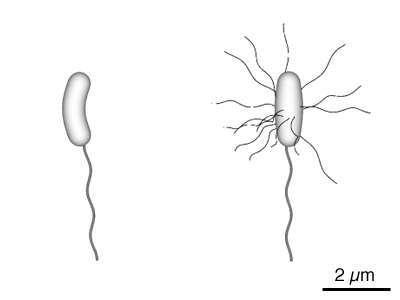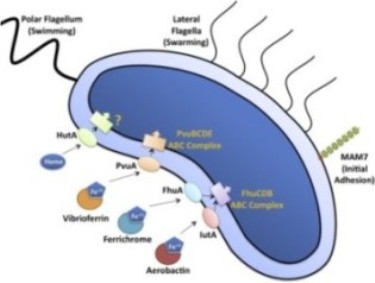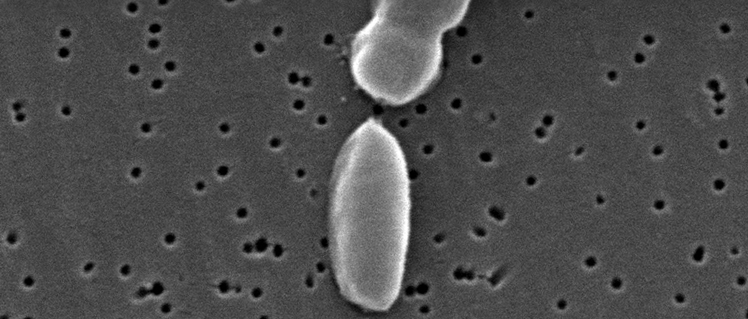Adaptation
 Vibrio parahaemolyticus
has some special adaptations when in specific environments.
The different environments can be liquid environments or semi-solid surfaces.
The organism adapts their flagellum and toxin when these changes
occur.
Vibrio parahaemolyticus
has some special adaptations when in specific environments.
The different environments can be liquid environments or semi-solid surfaces.
The organism adapts their flagellum and toxin when these changes
occur.
For a little background, V. parahaemolyticus is a curved rod shape, the same as a comma, bacterium. A different bacterium shape is coccus. Coccus is short and round, similar to a sphere. An example of a bacterium that has this shape is Staphylococcus aureus. For more on the coccus shape, see this interactive Coccus Bacteria website.
In the liquid environment, V. parahaemolyticus can adapt its flagellum. These environments are marine or estuarine environments. In liquid, production of a single flagellum at the base of this free living bacterium is formed. This flagellum consists of six different proteins. The polar flagellum is also sheathed and could help the bacterium in attachment. The single flagellum allows for swimming in the liquid environment. With the single flagellum, V. parahaemolyticus can reach speeds up to 60 μm/sec. Energy for this flagellum to rotate is supplied by a sodium motive force. In iron-limiting environments, a lateral flagella forms during growth.
In the environment of semi-solid surfaces, V. parahaemolyticus
create multiple flagella on its
lateral side. The lateral flagella allow for
swarming mobility. The numerous peritrichous
and non-sheathed flagella help the bacterium to swarm the substrates. The
possible hosts for V. parahaemolyticus are either marine
animals or human beings.
numerous peritrichous
and non-sheathed flagella help the bacterium to swarm the substrates. The
possible hosts for V. parahaemolyticus are either marine
animals or human beings.
There are a few differences between swimming flagella and swarm flagella. The swarm flagella are only made from one flagellin protein, are not sheathed, and move via the proton motive force compared to the swimming flagellum. The change from a swimmer cell into a swarmer cell is highly regulated.
Another change that V. parahaemolyticus takes on is its toxicity. To find out more about the species poison check out the Toxins page.
